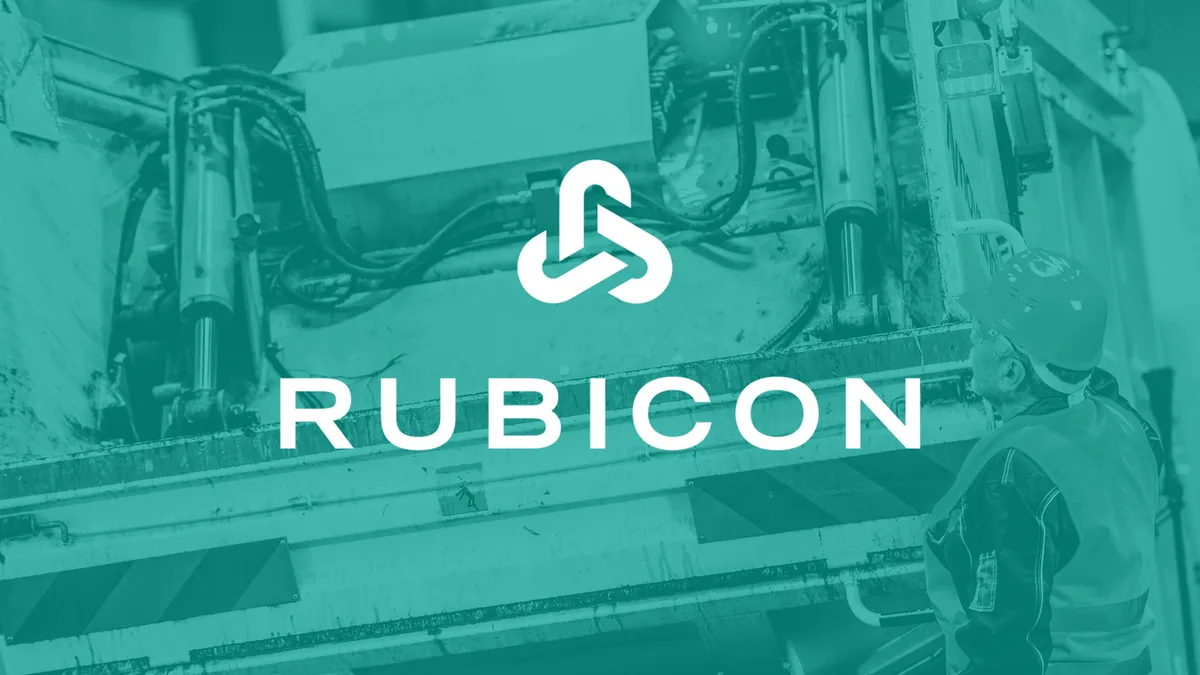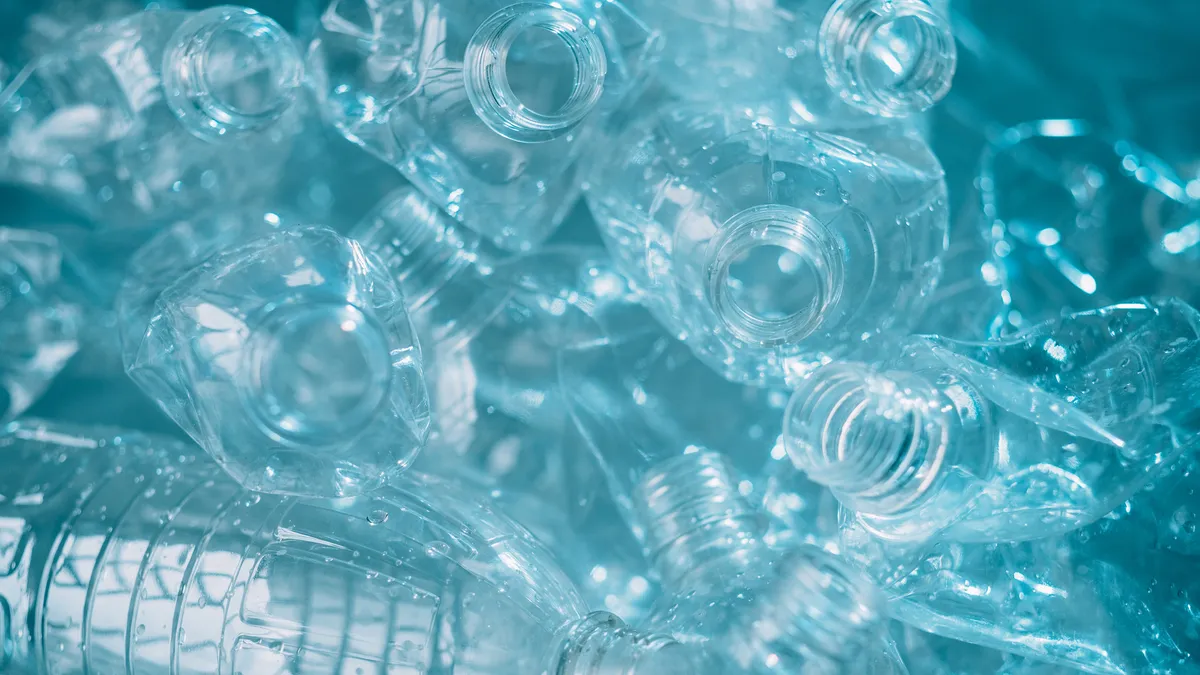With "zero waste" aspirations running up against contamination and recycling market realities, it's become confusing for businesses wanting to do their part. Rubicon Global has joined that conversation with a new educational tool to try and bring clarity to its commercial customers.
The "RUBICONMethod" outlines how to set up and maintain a successful business recycling program in six steps with a familiar acronym. DIVERT stands for Determine, Initiate, Vocalize, Eliminate, Roll-out and Track. This new guidance was developed with assistance from Recycle Across America and a nod to TerraCycle — both Rubicon partners. All three are supportive of limiting the amount of material going to landfills or waste-to-energy facilities.
By pushing a standardized system of procurement, bin placement, signage, employee education and analysis, Rubicon sees potential to help commercial recyclers break out of the common ruts of contamination and stagnation.
Waste Dive spoke to Vice President of Sustainability David Rachelson about the method's development, how China's import restrictions have affected service pricing, the state of single-stream and his thoughts on current circular economy trends.
The following interview has been edited for brevity and clarity.
WASTE DIVE: How long have you been working on the DIVERT method and how did it come about?
DAVID RACHELSON: We've been, in essence, working on this since the company began. What we set out to do really was to put our best practices into a universal tool to help businesses and municipalities better understand how to run a successful recycling and waste reduction program. We're a certified B-Corp and so our broad mission, our moonshot mission if you will, is to solve the global issue of waste and to create a more circular economy. To make the impact we desire we wanted to share these best practices with the world. We've found that a lot of businesses and municipalities really want to start a good waste reduction and recycling program, but it's complex. It's more difficult than turning out the light to conserve energy or turning off the faucet.
What's next for rolling out the method and how will that involve partners mentioned in the guide?
RACHELSON: We're in the process of socializing it and sharing it with our current customers, and using it as as a way to help potential customers understand the options that exist. Recycle Across America is a great partner of ours in the guide. We also discussed TerraCycle bins. They're a great partner as well.
The three organizations are really aligned in a few ways. [Rubicon and Recycle Across America have] spent a lot of time on making sure that materials are sorted properly and contamination is reduced, and ultimately the quality of materials that go to recycling facilities is as high as possible.
But as we know, recycling facilities don't accept all materials, and so that's why we set out to work with TerraCycle to understand or create a solution for those stubborn items. So this provides a holistic solution for businesses small and large, and municipalities, who are really trying to understand the how. How do you do this? People know they want to do it. Reduce, recycle, reuse makes a lot of sense. We wanted to show people how to do it.
I know Rubicon works to build route density, though I'd imagine current National Sword market pressures probably make the options different city by city. You might have a customer who wants to recycle certain things, but that's harder to do depending on the nearest MRF or domestic market. Is that accurate?
RACHELSON: So certainly there are inevitable ebbs and flows with different commodities and locations and geopolitical, in this instance, factors, even domestic issues. But if we take the holistic approach that begins with waste elimination, looks at rightsizing and optimization, increasing commodities and providing route density, we really are able in a lot of instances to find a total cost benefit. The method that we've rolled out is something that we think can ultimately help our business model by lowering the amount of landfill volume and increasing the amount of commodity output.
Understood, but if some of these commodities are seen as not being valuable at the moment — once again on a regional basis — that has to complicate the conversation, right?
RACHELSON: Yeah, it definitely does. However, as you note, it's very regional. We still see in most instances that while there has been a impact to the commodity rebates, with our total cost and total portfolio approach it's still more favorable to send materials to commodities streams than to a landfill. Moreover, what we've found ... is that a lot of companies are really wanting to reduce their landfill volume and help contribute to a more circular environment. So that's something that we are focused on as well, which is helping these companies achieve their "zero waste to landfill" or their circular economy goals.
Is it correct to say the RUBICONMethod assumes single-stream recycling will still be the predominant approach?
RACHELSON: Yes, that is right. You know in almost all instances at a mass scale, when complexity is added consumer adoption declines ... We really want to avoid customer and citizen apathy when it comes to recycling.
In addition, the decision has been widely adopted throughout throughout the U.S., in both the commercial and municipal setting, to go to single stream. So the solution is not to change back to multi-stream recycling, but to determine how to maximize and gain the intended benefit of recycling in single-stream and to help customers contaminate less and ultimately recycle more.
I know a lot of the clients that Rubicon started with had multiple locations or large operations where you could get economies of scale with recycling. How does that translate to smaller business clients you've been focusing on lately?
RACHELSON: So what we've found with the small and medium business is that there's a lot of opportunity and desire to get it right, but not a lot of knowledge about how to do it.
In terms of how we do it, I alluded earlier to the route density, which helps lower the fixed costs for haulers, and that is something that's fundamental to scaling the ability to recycle cost effectively in small and medium business. It helps when you cluster in markets and really focus on gaining a scale of customers. It's certainly a challenge, but also one that we're committed to solving.
On the flip side of that, we've seen a lot of big companies set corporate sustainability goals that include recycling. Do you have clients that are fine paying more, especially for something like organics?
RACHELSON: There is a value component related to achieving environmental performance goals. Companies really want to demonstrate that to their stakeholders and shareholders. There are numerous studies that show that the millennial population, which is starting to get a strong share pocket in terms of income, are willing to pay a premium for these products. So that's something that we're actually actively looking into doing, looking at both sides. Obviously, raising the top line to the extent we can, but always keeping an eye on the bottom line.
Beyond National Sword, what recycling or circular economy trends will you be watching in 2018?
RACHELSON: A trend that is very I think important, and one that the Ellen MacArthur Foundation is really leading up, and we're an emerging innovator within that organization, is breaking down the silos within the value chain. So making sure that, let's say the designers that are on Madison Avenue are designing things that the chemists at companies like BASF can design in a way that customers want, but that also creates life beyond their single use.
So I think a big, important trend for me is the development of products that are not only recyclable, but accepted in very common locations. Because that makes it easier for people to really want to do the right thing.
It seems like a lot of that conversation is being driven by nonprofits and associations and there's still a disconnect between some consumer goods companies and the industry. They design packaging and then the recyclers have to figure out what to do with it, and it could take years to adapt. Any hope of speeding that process up?
RACHELSON: I think that the business community is really starting, and has been probably for about the past maybe 8-10 years, to get beyond some of your most likely candidates like a Wal-Mart into other industries like Coors and beverage to demand "zero waste to landfill."
If you think about it, the reason that people want to be "zero waste" to landfills is that this whole make, take, landfill way of doing things, that has been done for time immemorial, really ignores the value that remains in these items. There's so much opportunity if they can continue to extract value into supply chains. It also means that you don't have to unnecessarily mine or destroy virgin resources to get those same materials.
So yes, you're absolutely right that a lot of work needs to be done. But you at the same time have seen really strong companies, right? You have a fundamental responsibility to return shareholder value in the form of their stock price, demanding at the same time these circular economy solutions. So that's really encouraging and something that we see our business model set up to to capitalize on.






















